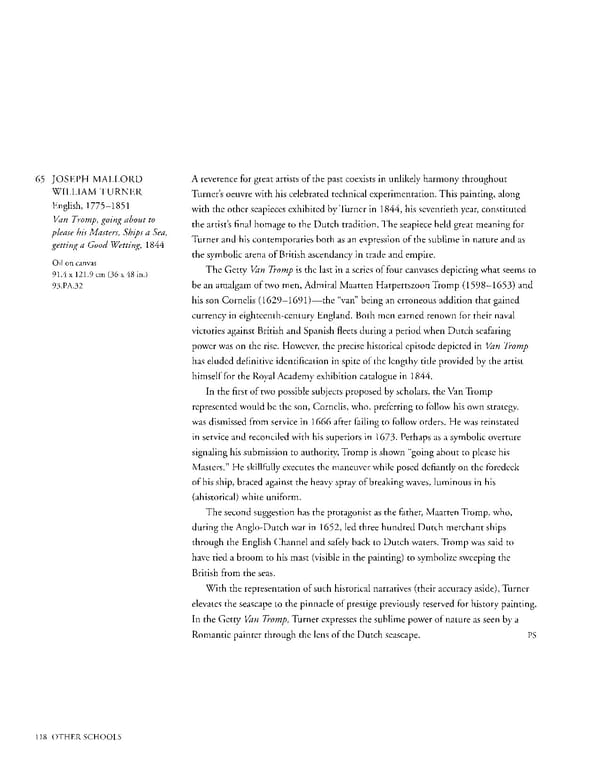65 JOSEPH MALLORD A reverence for great artists of the past coexists in unlikely harmony throughout WILLIAM TURNER Turner's oeuvre with his celebrated technical experimentation. This painting, along English, 17751851 with the other seapieces exhibited by Turner in 1844, his seventieth year, constituted Van Tromp, going about to the artist's final homage to the Dutch tradition. The seapiece held great meaning for please his Masters, Ships a Sea, getting a Good Wetting, 1844 Turner and his contemporaries both as an expression of the sublime in nature and as the symbolic arena of British ascendancy in trade and empire. Oil on canvas 91.4 x 121.9 cm (36x48 in.) The Getty Van Tromp is the last in a series of four canvases depicting what seems to 93.PA.32 be an amalgam of two men, Admiral Maarten Harpertszoon Tromp (15981653) and his son Cornelis (16291691)—the "van" being an erroneous addition that gained currency in eighteenthcentury England. Both men earned renown for their naval victories against British and Spanish fleets during a period when Dutch seafaring power was on the rise. However, the precise historical episode depicted in Van Tromp has eluded definitive identification in spite of the lengthy title provided by the artist himself for the Royal Academy exhibition catalogue in 1844. In the first of two possible subjects proposed by scholars, the Van Tromp represented would be the son, Cornelis, who, preferring to follow his own strategy, was dismissed from service in 1666 after failing to follow orders. He was reinstated in service and reconciled with his superiors in 1673. Perhaps as a symbolic overture signaling his submission to authority, Tromp is shown "going about to please his Masters." He skillfully executes the maneuver while posed defiantly on the foredeck of his ship, braced against the heavy spray of breaking waves, luminous in his (ahistorical) white uniform. The second suggestion has the protagonist as the father, Maarten Tromp, who, during the AngloDutch war in 1652, led three hundred Dutch merchant ships through the English Channel and safely back to Dutch waters. Tromp was said to have tied a broom to his mast (visible in the painting) to symbolize sweeping the British from the seas. With the representation of such historical narratives (their accuracy aside), Turner elevates the seascape to the pinnacle of prestige previously reserved for history painting. In the Getty Van Tromp, Turner expresses the sublime power of nature as seen by a Romantic painter through the lens of the Dutch seascape. PS 118 OTHER SCHOOLS
 Masterpieces of the Getty Museum: Paintings Page 118 Page 120
Masterpieces of the Getty Museum: Paintings Page 118 Page 120